


Around the world, there is a generally accepted way to uncover new scientific principles; the Scientific Method.
There aren’t very many steps in the scientific method, but each one is crucial and is of little use on its own. The primary purpose of the scientific method is to confirm or invalidate a hypothesis about the origins of something observed. In other words, the scientific method helps us make sense of the world around us, and

Today we are going to dive in to some media production. The goal is to create the messaging around the product/offering that we intend to sell with our business.
This is going to take some creative thinking, but we deafeningly don’t want to over-think this step. Perfect is the enemy of good here, and we are shooting for good enough – which might actually be a little less than good..? I’m not sure…
Anyway, as we create some example ads to place in front of our target demographic, we want to move quickly. Spending too much time before we start testing will result in fewer test runs of our ads. And fewer data to work with at product launch.
So, what are the elements of good ad content? How do we know if we’re on the right track? Let’s get organized and follow this outline to get the answers we need to make good Ad Copy and Visuals.
- Who will be receiving your ads (audio/video/text)?
- What are the goals of your ads
- How are others accomplishing this same goal?
- How can you learn from their implementation?
- What consumer behaviors do you need to keep top-of-mind when sharing your message
- When do you make the call to action? (trick question)
Who will be receiving your ads?
We have been working through our target demographic and our dream customer since the first day. While we might not have the names of the people that will be receiving our ads, we should have a pretty good idea what type of people they are.
When preparing your ad copy, it’s very important to keep in the front of your mind the image of of your target customer. In marketing, an imaginary person who represents all your real customers is called a persona. This person is the perfect combination of customer characteristics that help you remember what your customer is like and what they like.
Action Item: A good way to keep your persona front and center is to actually have a picture of a person that you can look at. Let’s do this together. head over to unsplash.com and grab a picture of a person. Think of a male and female names for the people you who will represent your target customer. Search for the the word ‘persona’ and see who comes up.
Next, find the person that appears to match the names you have selected most closely. I picked the names Brandon and Ciara. And here are the pictures I’ve selected for the personas:


Now, think of some characteristics that these individuals have that make them your target customer.
Brandon is 23 years old and works part time and goes to school full time. He likes to play video games with his friends, and goes on the occasional date with girls that he meets while studying in the cafeteria at his university. He owns an iPhone, and a MacBook, and listens to alternative music.
Ciara is 21 years old and works full time and is in her last semester of college. She studied Computer programing with an emphasis in 3D design. She is happily single because she is too busy for dating right now with college ending and her job ramping up. She fined the time to occasionally play console video games with some of her guy friends who are dependably available for a late night game of Fortnite when she’s in the mood to join. She owns an iPhone, Watch, AirPods, and a desktop PC that doubles as a workstation for 3D design and high end PC gaming.
What are the goals of your ads?
Now that we have an idea of who are target demographics are, we can make goals around the response we’re hoping for when they watch/read our ads. Specifically, what will I need to say to Brandon and Ciara to get them to act? And what specifically am I hoping they act on?
For this exercise, I want them to tap a link that is in an ad in their Facebook news feed. This link will take them to an app download page that will have them download an iPhone app. The app is designed to be a companion to their desktop or console Fortnite game.
I will need to create a message that makes tapping that link a no-brainer. To make the move to tap the link and download the app, there are things they need to feel and think before they do what I’m hoping they’ll do.
How are others accomplishing this same goal?
I had an interesting experience the other day when I was trying to answer this specific question about the fortnight app idea. I was doing research trying to find where of the existing Activella first published their work, and I wasn’t having much success through Google. fortunately, Facebook to the rescue!
As part of a commitment to be more open about how your data is being used for marketing purposes, Facebook will now tell you what adds have been run via various Facebook business pages.they also provide information about the type of business that is running the advertisements. You can imagine this is particularly valuable during an election here where unnamed entities can abuse the user data that Facebook provides to advertisers.
I wasn’t interested in the political aspect of this new future, I just wanted to know what type of advertisements were being run by some of the other competitors and my target market.
How can you learn from their implementation?
It’s important to note that not everything that shows up often in your newsfeed is something that is ejective with the higher in quality. With enough money, you can brute force your way in front of millions of people on Facebook.
But, you can still learn from those with deep pockets. One of the best ways to create your marketing and sales funnel is to go through as many of your competitor’s sales and marketing channels as possible. You don’t need to go through all of them, but as you identify some of the more successful brands, you should become a customer so that you know what experiences you should be creating for your customers. Attention to how you are treated, what type of offers are made to you, and how there pricing and value ladder are configured.
There are some built-in tools that you can access through facebook’s website that are filled with rich data. One specific tool is the Facebook Ad Library. This library contains all the ads that people are currently running on Facebook, as well as a history of ads that ran previously but are no longer live.
This resource can be incredibly valuable if you are trying to get an idea of the type of creative content you need to make to get the attention of your target audience.
As an example, I went into the Facebook ad library and searched for Fidget Spinners. I was able to find a product that was running ads back in August of 2018. The Facebook Ad Library listing included a video with links to shop for the fidget spinner that was featured in the video. In addition to seeing what was part of the ad, Facebook also shows you how much was spent on the ad as well as how many impressions the add had. An impression is counted if the ad is in the news feed of a person using Facebook or Instagram. The particular ad had between 5-6k impressions and the brand running the ad spent less than $100 total.
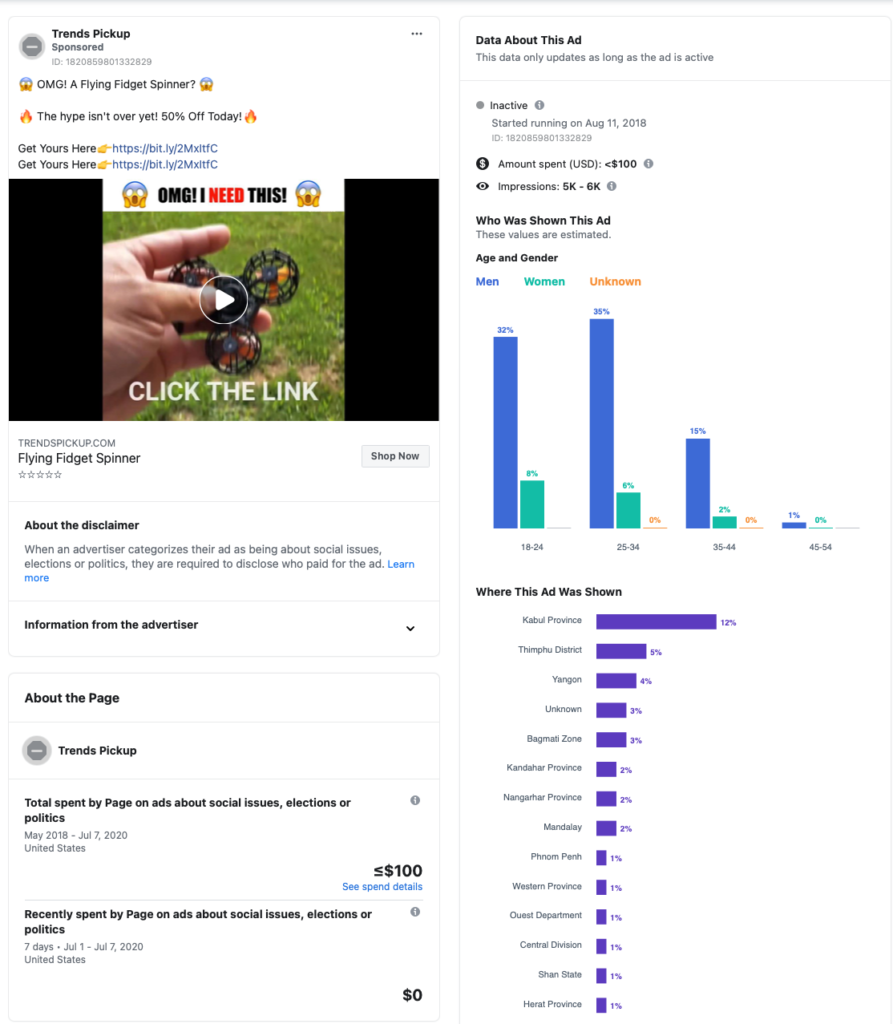
What consumer behaviors do you need to keep top-of-mind when sharing your ad message?
As we discussed earlier, creating advertising messaging that is conversational and nature and speaks directly to your various personas is the only way to market these days.even the big name brands are delving into this market and trying to maintain their foothold bye creating messaging and providing value they traditionally I have ignored.
Fortunately for all of us entrepreneurs in the world, authenticity comes naturally. Which, ironically, makes you seem more authentic. It’s a virtuous cycle. be yourself to be authentic, and be authentic so you can better serve your customers.
When do you make the call to action?
There have been many examples of individuals who missed out on great opportunities because they simply forgot to ask for them. Keep in mind that anyone watching an advertisement is subconsciously waiting for some sort of invitation or call to action. Your call to action should be communicated just as naturally as you communicate your offer.
Once you master death, they will blend into the same single message. And that is, you have something of value and you would like to offer it to them. If done right, your only question is, “where would you like me to deliver it? “

Selecting the right ad-platform can seem daunting at first. Should you post on social media, or should you focus all of your content on your own website? Answer to this question has multiple parts.
First, there is something very important to consider when thinking about the platform that you will publish on. The number one thing you should think about is who holds the traffic that will see your content and your advertisement? in the marketing world there are three types of traffic. Those that you buy, those that you earn, and those that you own. Let’s talk about each one individually.
Customer Traffic That You Buy
During the 30 day business framework, the majority of the traffic that will be exposed to your products and offerings and will be traffic that you pay for. This isn’t necessarily a bad thing, especially if you don’t already have a large following online.
If done correctly, paid traffic can be a very lucrative way to earn a lot of money and very little time. But, there is a trick to it and a risk associated with it. The trick is finding the right ratio of advertising money spent to money earned from sales.
For example, if I pay one dollar to get a customer to purchase my product that cost three dollars, and I’m getting a return of 200% on my advertising money spent.like we discussed in previous sessions, your cost structure is very important to keep in the front of your mind. If you have high product costs as well as advertising costs, you will need to sell for more product at a much higher price to be profitable.
But we don’t need to cover cost models here. We already discussed that any previous section and you can go back and read it if you need a refresher.
Currently some of the most popular places that you can pay for customer traffic our Facebook, Google, Twitter, and the less popular option is Bing which is Microsoft search engine.
The traffic is sold to you via an automated bidding system that measures how many people you will be able to advertise to as well as how many advertisers would like to be in front of that audience. After those two metrics are measured, a price is assigned to the advertising slot.
So, you can imagine that the best strategy when you’re just starting out is to find a niche that doesn’t have very many competitors in it, but has high enough volume for you to make meaningful sales. All of the extremely high volume search terms and high volume of customers are very likely already occupied by the big name brands that can outspend you $1 million to one.
But, this shouldn’t deter you. All of the planning and strategy that we have been doing up to this point was meant to prepare you specifically for a scenario where are you find the niches and customers that are not served or underserved by bigger brands.
The final thoughts on customer traffic that you buy. At the end of the day this traffic is not owned by you or even earned by you, because you had to pay for it. And the harsh reality is one day you will be having wild success and the next day some algorithm will change that takes your advantage away completely. And your left to the mercies of the platform owners and their discretion dictates the futureof your company. Not the best place to be in long-term. So, having other strategies in place to drive traffic to your offering is the best way to avoid his scenario that is out of your control.
You’re probably wondering what other ways you can drive traffic. That’s great! The next two sections talk specifically about that.
Customer Traffic You Earn
Customer traffic that you earn is different from customer traffic that you buy in that you don’t have to pay for it. However, it’s similar to traffic that you bye and that you are still relying on a third-party platform to constantly feed you new customers. I don’t think these platforms will be going away anytime soon, but it’s good to be aware of your reliance on them so that you canplan your business appropriately.
So, how do you earn customer traffic?there are a few ways that you can earn customer traffic one of them is through search engine rankings. Knowing how certain things work to help you rank higher.
There are a lot of tactics and strategies and other mindbending techniques that people employ on the Internet just show up first in the rankings. But, these tactics and strategies are we coming less successful as the search engines are becoming better at reading websites like humans do. So what does that mean?
Let’s use Google for an example. Googles stated objective is to organize the world’s data so that it is accessible by everyone. Basically, do you want to be the best search engine in the world that provides the most relevant answers to their customers questions. So, thinking about that stated objective as a human would think about it helps us really understand how to give Google what they want so they will give you what you want. Hey number one ranking on their search engineso that it is accessible by everyone. Basically, do you want to be the best search engine in the world that provides the most relevant answers to their customers questions. So, thinking about that stated objective as a human would think about it helps us really understand how to give Google what they want so they will give you what you want. A number one ranking on their search engine.
It might sound counterintuitive, but figuring out how to rank at the top of the search results on Google has only become easier to understand the longer Google is around. And that’s specifically because of what I just mentioned above. Their data aggregation algorithm is getting better all the time looking at your website the same way humans would like at your website. In fact, you might be surprised to know that it wasn’t until recently I had the Google searchEngine crawler was able to view images and animations on your website in their appropriate context. Meaning, Google didn’t know the difference between a rich user experience and a bland one the incorporated text only. At least Google’s search ranking algorithm didn’t know this until recently. Fortunately for all of us, that is something of the past. And now we can make content rich websites with images, animations, videos, and text without worrying we will not be recognized for our hard work and creativity.
So, to answer the question how can you earn customer traffic. It’s easy. Create something useful on your website that other people can use. obviously you will want to create something that you are good at making. Quality matters a lot. If you are an expert photographer it wouldn’t make sense to fill your personal website with longform journal entries about the locations of your photo shoots. Your website should be filled with original photography with some contextual text to help explain what people are looking at.
To take a photography website to the next level, you might include answers to questions that people might have about locations for a photo shoots. Or photo composition. Or perhaps how to make money as a photographer. Questions like these are asked online all the time not just about photography.
Think about the last search you did on Google. Where did the answer come from?The website that Google referred you to earn your traffic. They earned the right from Google to be placed in front of you in response to a question that you typed in.
This applies to us as we work through our 30 day business framework because it’s better to have traffic that you have earned from your hard work than traffic that only comes to you when you pay for it.
Customer Traffic That you Own
The final type of customer traffic but we will cover is the customer traffic that you on. This is the type of traffic that turns online businesses into multi million dollar companies. Customer traffic that you own is exactly how the big names in marketing can have $20,000 weekends. Or even $1 million in a single week. They aren’t doing those impressive things through paid advertisements or even through organic ranking that they’ve earned on the search engines. They are leveraging customer traffic that they own.
If that last paragraph got you excited about customer traffic that you own, then I don’t feel so awkward with all of the butterflies in my stomach. It’s a very exciting prospect to imagine being able to reach people and provide them value in a way that can financially change your life overnight.
You’re probably wanting to know how you can home customer traffic. You’re also probably wanted to know if you can offer your product or service to people this weekend so that you can also have a $20,000 weekend. Well, it does sound nice, doesn’t it? The customer traffic that you phone takes a lot longer to grow. So I wouldn’t expect a $20,000 weekend anytime will be super near future. Maybe give it a few weeks.😉
When we talk about customer traffic that you own we are talking about email lists. Specifically, list of emails that people willingly gave you because they wanted you to continue to reach out to them as you created and provided value to them. There are plenty of ways to trick people into giving you their email. However, those people who feel tricked by you are very unlikely to ever become real customers. They end updo you do emails on your list that unsubscribe or never open the email. There’s no reason to add them to your list if doing so was a violation of trust. Not a great way to start a relationship.
So, how do you grow your email list? And how do you grow it with the type of people that want to hear from you on a regular basis. Better yet, how do you fill it with The emails of people that want to open their wallet because they find your products and services so valuable that they want to pay you for them?
The answer is pretty straightforward. You shouldn’t be asking for their email. Your goal is to have them accept your offer for more value sent to them through email. The difference between asking for their email and offering more value to them via email is worlds apart in principle but nearly identical in practice.
So, what does that look like? Imagine you are having a conversation with your favorite author. During this conversation you felt like the luckiest person in the world having the opportunity to speak to someone and hear new and fresh ideas from someone you respect. Now, imagine what you would think if at the end of the conversation the author turn to you and said “can I have your email so that I can add you to a list of people that I make money off of?“
Obviously those words wouldn’t be used. But you have been asked for your email online so many times from people with those exact intentions that those are the words you heard even if she didn’t say them exactly that way.
Now imagine a different ending to the conversation with the author. Imagine the author returned to you and said, “I’d love to send you some of my latest work. I have a very small group of people that I share some of my draft writings with on a regular basis. Does that sound like something You would be interested in? How would you like me to share this with you?”
There are a couple of important points I want to make about this second ending to the conversation with the author. First, the author wanted to provide more value., Which tends to me the other person feel important. Second, the author mentioned that she is not engaging in a mass marketing campaign to boost future book sales. He actually introduced the idea of exclusivity and scarcity. Third, he didn’t ask for anything. He made an offer. The only thank he asked for was clarification on how he should deliver his offering.
As you can see, and principal those two approaches couldn’t be further away from each other. However, the end result is identical. The author will walk away with another email of a raving fan. But the email address captured in the second scenario far more valuable than an email collected from the first scenario.

The first five days of The 30 Day Business have focused on exploring your top 5 business ideas. We have covered a lot of topics over the last five days, and hopefully, we have a good foundation that we can build on over the next five days.
If your experience was anything like mine, you’ve been able to think more about your top business ideas. The process of dismissing ideas that might have seemed promising but were red-herrings is liberating. The net result is you no longer have to carry these thoughts around with you. You’ve effectively cured some of your long-standing anxiety around some of your what-ifs! Great job!
If you didn’t have this experience of the last five days, that ok, you’re ahead of the game. That means you’ve been able to objectively assess your ability and opportunities before we started down this path. And that’s great!
Let’s go through the highlights of the first five days and make sure we’re all on the same page as we lead into the next five days.
Here’s an outline of what we’ll be covering in this part:
- Day 1: The filtering criteria used to Narrow to 5
- Day 2: Business Structure and Value Proposition
- Day 3: Resources Required to Operate and Build Product
- Day 4: Total Addressable Market
- Day 5: Narrow to 1
Filtering Criteria used to Narrow to 5 on Day 1
On Day 1, we did a lot of brainstorming and put in some serious work to figure out what five business ideas we were going to test. We discussed the DAFT model that guided us through idea validation steps. DAFT stood for Document, Evaluate, Focus, and Test.
We also discussed the Business Objectives that our business ideas would have. This section had us think about why we wanted to build a business in the first place. Some of the objectives we covered were Growing Revenue, Creating Free Cash Flow, adopting something more meaningful for ourselves, improving brand perception, or solving a specific problem.
Finally, we answered 27 honest questions about our idea. These questions were not soft-balls. They were heavy-hitting and required us to think objectively about our business ideas. At the end of that process, it was relatively easy to narrow to five ideas that we could move forward with into day 2.
Day 2: Business Structure and Value Proposition
On the second day, we talked more about our customers, how to know who they are, and how we will interact with them. As part of the discussion, we covered what channels we will service our customers through, and what service structure we need for our specific customers. We learned that not every product or service can or should have the same customer support structure, as customer relationships will vary greatly. An example we reviewed was the difference between a subscription service for household necessities and a mobile application for gamers. The subscription service would benefit from a more hands-on, real-time interaction with a real person where the mobile app support structure would likely only need proper online documentation. The products and target demographics were very different, so the support structure required some of our best creative thinking to get right.
The next big topic covered on Day 2 was our value proposition. We covered at length the Jobs-to-be-done theory and how our customer segmentation should not be based on traditional marketing strategies. Instead, our customer segmentation should be based on the people who are hiring products like ours to perform specific jobs for them.
On Day 2, we finally discuss revenue streams and the different ways that we can make money with our Business Ideas. This is another area where the way your make money can be very different depending on the type of business you establish.
Some of the different revenue streams we discussed were one time purchase payments, subscription payments, recurring payments for consumable goods, and time-based access fees that are not recurring.
Day 3: Resources Required to Operate your Business and Build your Products
On Day 3 we dove deeper into there business canvas and completed the worksheet by answer questions about Key Resources, Key Activities, Key Partnerships and Cost Structures.
We thoroughly covered different scenarios for each of these concepts, and walked through an example cost model that ended with the hypothetical bankruptcy of a fidget spinner company. We learned about the importance of keeping track of company costs, as well as market moves to avoid having our margins negatively impacted.
There was also a separate post written specifically about the Importance of Partnerships. In that post we covered what types of partners you’ll need to work with, and what compentncies you’ll need to posess if you are not able to fill those parts of your business with solid partnerships.
Day 4: Determine Addressable Market – Demographics, Geography, and Size
On Day 4 we did an exercise to help us think through the analysis we will need to do to find the size of our market. We walked through the thought process of figuring out how many tires are sold in the USA every year.
We learned about the importance of asking the right questions. We also learned about indirect evidence that could help us learn more about the core questions we are trying to answer. With the example of car tires, we quickly learned that knowing the total cars in the USA as well as the total number of people in the USA would help us learn more about car tires – even though those numbers were indirectly related to tire sales.
A challenge was issues to try to uncover the total number of boxes of cereal that are sold each year in the USA – without actually looking up the answer. The goal isn’t find the right answer, but flex your mind and practice thinking analytically about how the market operates and what type of buying habits exist in the world today.
Day 5: Finalize your Initial Market Research and Narrow Ideas to 1
You might not feel ready, but today is the day! You need to narrow your list of ideas to one go-forward idea. You might not be completely confident that you’re ready, but I assure you that you’re as ready as you’re ever going to be!
So, what is your idea that is going to get your full attention over the next 25 days?!
A Word on Partnerships
As we work through this 30 Day Business framework, I feel compelled to further emphasize the importance of creating the right partnerships. This is especially true when you are starting a new business. At the early stages in the lifecycle of your business, your most valuable assets are the partnerships you can create. The partnerships with your suppliers, the partnerships with your customers, the partnerships you nurture and develop with your co-creators in your business.
All these partnerships are crucial to your success early on. Not surprisingly, these partnerships are the seedbed in which you are able to scale at the proper time. The right partners will facilitate and compliment your efforts.
There is one set of partnerships that I wanted to dive a little deeper into as we finalize the go-forward idea for our 30 Day Business Framework. Specifically, I want to explore who we need to partner with to design, build, offer for sale, and finally deliver to our end customers.
As part of the Day 3 exercises, you were asked to map out the Key Resources, Key Activities, and Key Partnerships that are required to build and delivery your value proposition (product) to your customer. The importance of doing this right cannot be overstated. You must know how your product design partners are. You must know who your development partners. You must know who your sales channel partners are.
So, let’s map that out and write a few things down:
Who specifically, are you going to partner with for designing your product?
Who specifically, are you going to partner with for product development?
Who specifically, are you going to partner with for advertising your product?
Who specifically, are you going to partner with for the sales of your product?
Who specifically, are you going to partner with for the delivery of your product?
Who specifically, are you going to partner with for the support and customer service for your product?
You might be scratching your head right now, wondering where you are going to find the right people with the right skill sets to meet all these different demands for your business. Don’t worry, we’re going to review some resources you can leverage as well as ways that you can meet many of these partnership requirements yourself until you find more permanent partners.
I’m going to talk about the idea that I’m likely to move forward with, and we’ll try to extract principles that can be generally useful for your ideas.
I’m leaning toward 2 different products, maybe 3. My choices are between 1. The subscription website, 2, the Fortnite Mobile App with Ads or in-app-purchases, or 3. The Photo filter App that I have worked on but not yet finished.
For this exercise of selecting Key Partners, I’ll use the subscription website as an example. But only because that’s the hardest one with the highest number of moving pieces.
Lets work our way down the questions listed above:
Who specificailly, do I need to work with to design this product?
Me: design and build a basic website. The subscription website is being made with a popular website building technology called WordPress. Deploying a WordPress website is something I’ve done hundreds of times over the years, and I will be the person deploying the first version of the subscription website.
Me: design and implement payment processing. The payment processing for the website will leverage Stripe’s payment technologies. I have implemented stripe payments before, so the initial setup shouldn’t be too difficult. I have never deployed a payment solution that included recurring payments. However, I have read the technical documentation on it, and there are only a few minor tweaks and differences between what I’ve done before and what is required for the proper deployment of recurring payments.
Who specifically, are you going to partner with for product development?
[Unknown]: supplier(s) of first subscription offerings on the website. This is a huge gap in my plans, and I need to start looking for the proper partner and products that will be most desirable to my target customers.
Who specifically, are you going to partner with for advertising your product?
Facebook: when selecting a partner for advertising, there are two critical considerations. First, your advertising partner needs to have access to lots of people’s eyes and ears. Second, your advertising partner needs to have a massive amount of information about those eyes and ears.
Facebook has nearly 2 Billion active daily users. Each one of those users has permitted Facebook to know something about them. Facebook also knows things about these people that, perhaps, they don’t want Facebook to know. (We won’t spend time here discussing the ethics behind Facebook’s user data policies).
The data that Facebook has available to it, and that it extends to those that advertise on their platform is extremely valuable! When you wear your marketing hat, you are looking for your target demographic. You’re trying to decide where they are, who they are, and what problems they are trying to solve in their lives (e.g. the jobs they are hiring products for).
While Facebook doesn’t have a ‘jobs listing’ of the available opportunities you can leverage, it does allow you to put your product offering in front of specific groups of people that your market research indicated might be interested. Your efforts to place your offering in front of these people – at least initially – will be to validate your assumptions, not to sell a product.
To be clear, we don’t want to invest the time, energy, and resources to build a product that has not been validated with data. The data will tell us if we should proceed. And that is what days 5-10 are all about!
Who specifically, are you going to partner with for the sales of your product?
WordPress, WooCommerce & Stripe: I plan to leverage platform technology from WordPress, WooCommerce from Automatic, and Payments from Stripe. The three of these companies all offer free tiers of their products, or will take only a percentage of sales when you have sales.
This way I don’t have to pay for a payment processing solution before any money is flowing! Save your money until you make some money!
Who specifically, are you going to partner with for the delivery of your product?
[Unknown]: Ideally the partner who will be providing the subscription service has some sort of logistics and shipping functionality they leverage. However, as this will be a new partnership for them, I shouldn’t expect to just plug in to their existing systems as they might be at capacity or they might not offer services in a way that are compatible with my business model.
As a result, I need to answer a few questions about product delivery before I can move forward with confidence.
- If I need to store products, who is a wear hosing provider that I can partner with to store the subscription products before sending them to the end customer?
- Who is a shipping provider that I can partner with to ship product from my product partner to my warhorse? And can this shipping provider also handle the sending of product to my end customer?
To get the type of support need, I will have to find a 3PL partner. (3PL stands for Third Party Logistics). Working with a 3PL has its advantages and disadvantages. So, I’ll need to discover and decide which trade-offs I’ll be willing to make and how they will impact my margins.
Who specifically, are you going to partner with for the support and customer service for your product?
Website, Email, Forums, Forwarding: Ideally, I only want to provide customer support for those parts of my service that are within my control – or at least those services that my website communicate that I’m in control of. For example, I might not be doing the actual charging of their credit card, but it would be unreasonable for me to expect users to head over tor Stripe’s website for support on a failed transaction on my website. Similarly, if the WooCommerce or WordPress elements of my site don’t work properly, I should plan to support those issues directly instead of forwarding my customers to WordPress or WooCommerce for troubleshooting or support.
On the other hand, if there are issues with the quietly of on elf the products inside of the subscription service, especially if that product is part of my supplier partners product offering, It would be in everyone’s best interest of those questions are directed to my supplier parter to resolve.
Of course there is a right wand and a wrong way to forward customer service issues to external parties.
The right way too forward support issues looks a little something like this:
A customer reaches out because a bottle of supplements was delivered with the seal broken and they would like a replacement. This is a completely reasonable request, and you absolutely want to service this customer and satisfy their request. In essence, you definitely want your customer to have a good experience as they go through the process of getting a replacement.
You might even be thinking to yourself that there might be an easy way for you to fulfill this request, instead of forwarding it on to your supplier partner. But, in this scenario, you didn’t set up the relationship with the supplier that way, so you must forward the customer on.
Before you started sending product to customers, you met with your product supplier and wrote up an agreement on what types of issues would be forwarded to them and which types of issues you would handle yourself. You decide that the supplier would handle manufacturing and product defects, along with replacement requests, and you would handle order processing and delivery issues.
Along with the devision of labor around what areas each party would handle, you also agreed on what type of response was appropriate for what type of issue.
Since the issue with the customer receiving a product where the seal was broken fall in the product or manufacturing defect area, your supplier partner is happy to handle it and promptly sends a new bottle of supplements to the customer. Everyone is happy.
Corner Cases:
You can probably imagine where there is a gray area, or where the two areas of responsibility overlap. Here’s one example in case your imagination hasn’t wandered into these areas before (I don’t blame you, logistics can seem boring until things go wrong. Then they are not only boring, they are annoying).
So, the scenario includes a customer wanting to return something that they argue is defective, but your supplier partner says is actually meets their quality standards. Because you have responsibility for the delivery of products, you also assume that sending items back to the supplier also falls within your area of responsibility. After all, your logistics partner makes is super easy to ship items back to their origin from customers, and including ‘free return shipping’ was part of the package you paid for. So you happily offer that to your customers.
So the customer executes a return and you refund their money.
The issue comes when your supplier partner received a return shipment and you ask for a credit for the value of the order. The return order arrived with most of the products open, which made them unsellable to another customer.
Your supplier partner isn’t happy about this, but agrees to swallow the cost on this order, but wants to have a meeting with you to discuss how this particular situation should be handled in the future.
Action Item:
How would you successfully navigate the upcoming conversation with the supplier partner? Why type of financial and brand value questions should you keep in mind when discussing the return policy? Are there any core business principles that your business has adopted that requires you to respond in a specific way? How important is the idea that the customer is always right? Where do you draw the line?

Where are Your Customers, and how many are there anyway?
You might not have considered thie question before, or perhaps you have subconsciously answered it and the set it aside. But the answer to this question is never found in your own mind. At least the answers that you tell yourself can be drastically innactuate.
Imagine if the total number of potential customers for your proudct was only 100 people; world-wide. Image what that would mean if you were designing and building a product that you $50. Well, you can probably guess what would happen next. You’d make at-most $5,000 and then have nobody else to sell to. Actually, you’re likely to make far less than $5,000 because not everyone that is a “potential” customer is an “actual” customer.
Either way, your build a product for a demographic so narrow and small that you have to close down your business.
This extreme hypothetical is mean to draw attention to how crucial it is to confirm there is a market for your product. Is there a group of people (with money) that want your product? How many people are in that group? Where are they? Who are they? What jobs are they hiring products to occupy? What problems are they trying to solve?
Answers to these questions is exactly what we are going to cover in Day 4.
We’ll tackle this topic following this rough outline:
- Who is the customer for my product
- What is the size of the total addressable market for my product
- What is the size of the served market for my product
- What is the size of the target market for my product

Day 3 is all about creating the blueprints that outline how your business will operate and the type of inputs required to launch and sustain it over time! Today we are going to cover 4 core concepts that are the foundation of your business operations and product development efforts.
We will be covering the following:
- Key Partnerships
- Key Activities
- Key Resources
- The Cost Structure of your Business & Product Offering
As we’ve done in previous parts, we are going to start with the overall structure of what we are going to cover today. Then we will start at the end and work our way backwards so we are confident each step of our process is appropriately leading us to our desired result.
Cost Structure of Product Offerings
On Day 1 we did some back of the napkin financial projections for the business and products that we were brainstorming.
Today we are going to dive a little deeper and do some additional analysis to get us closer to our final idea candidate that we will move forward with after Day 5.
First we are going to talk about the Cost Structure of the Product or Service that your business idea will generate.
A great way to get a good picture of data is to create a chart. So, let’s build a chart that includes all the different elements that go into the cost of building a product.
We’ll start simple and then add elements as we go so we can see the full picture.
Imagine we are going to sell a fidget spinner. The complexity of the cost model that we create to capture the cost of selling fidget spinners is largely dependent on how much of the process we want to be involved in. If we intend to only participate in the resale of existing fidget spinners, then our cost model will have very little detail around the cost of the fidget spinner. The cost would be the price we purchase the fidget spinner at, plus any logistics cost like warehousing and shipping.
On the other hand, if we want to do more than just sell existing fidget spinner designs, if we want to design new ones and manufacture them ourselves, our cost model immediately becomes much more complex.
Like most things we’ve covered, there are some trade-offs when deciding how much of the product development process you want to be involved in. When you take on the entire development process, there are many more cost elements that you’ll need to keep track of. However, if you are able to take on more of the development cost, you stand to make more money in the end because the margin that your fidget spinner supplier was making when you purchased from him/her is no longer part of the costs you have to absorb.
Lets look at an example of this:

The first chart is the simple cost model where you are only interested in reselling existing fidget spinners. You are able to purchase them for $1.10 and have a cost of $0.05/unit plus $0.30/unit to ship them to their final destination. Let’s assume that consumers are able to purchase fidget spinners like the ones you are selling for about $5. With this simple cost model, you’ll have a $2.45/unit margin. That’s a 49% gross margin – which is pretty good.
Now, let’s say hypothetically that some competition entered the market, and they were selling their fidget spinners for $4. To make matters worse, they are actually buying from the same supplier that you are so they are offering the exact same product for $1 less. Which means your sales are starting to tank – and lots of people are starting to ask for refunds!
So, you bite the bullet and lower your prices to $4/unit. Now your profit margins are at 36% and your sales volume has been cut in half because another player has entered your market! How rude, right?!
To continue with this hypothetical, your direct competitor again lowers their price, this time to $3. Now you have a serious problem!
With the competition lowering their price to $3, you are forced to lower your price as well, or cede the market. So you do. But now you have some serious problems because your margins are 15% and you are making $0.45/unit.
To explain why this matters, we need to understand how your product margins impact your overall business margins. Because, not only do you need to cover the cost associated with buying, storing, and shipping fidget spinners with the money generated by each sale, you also need to cover the costs of running the rest of your business. And, oh yeah, you need to pay your self too!
So, let’s take a look in the next section what sort of problem you’re facing with this competitor coming into your market and driving down the price.
Cost Structure of your Business
To start out, we’ll make a few assumptions about how many fidget spinners you’re able to sell in any given month. We’ll say you originally were selling 20,000 fidget spinners per month and $5/unit before your competitor entered the market. This is scenario 1.
Once your competitor entered the market, your sales volume was cut in half, and you were then selling 10,000 fidget spinners per month at $4/unit. This is scenario 2.
And finally, your competitor reduced their price to $3/unit and so your response was to reduce your price as well. You then were selling 10,000 fidget spinners per month at $3/unit. This is scenario 3.
As you can see in the chart below, something pretty awful happens to the viability of your business as the price reduces and all other expenses stay the same:


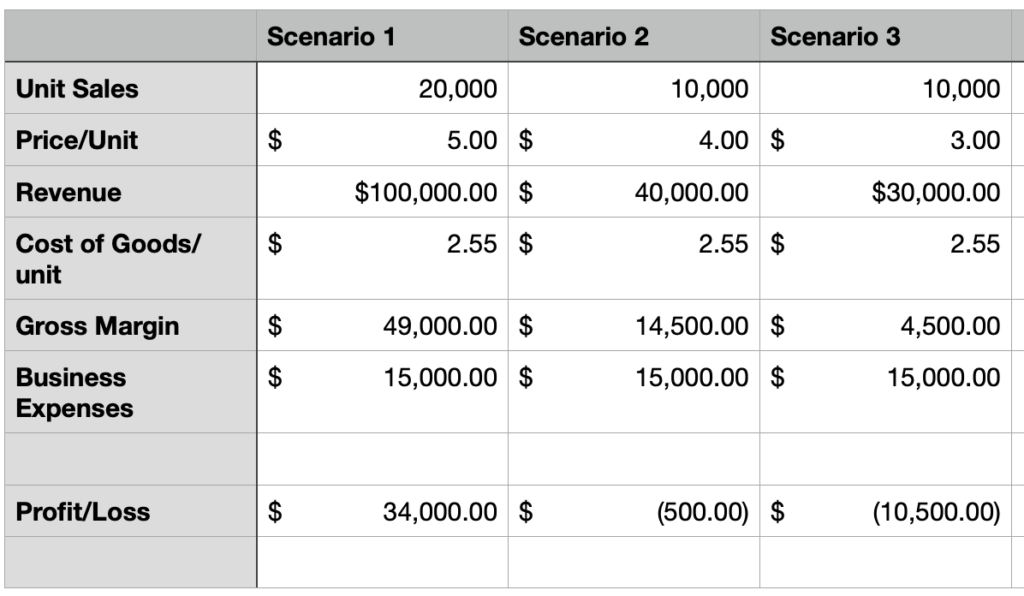
If you look at scenario 1 in isolation, you’d feel pretty good about your business. Your gross margin is healthy, your business expenses are reasonable, and your net profits are also pretty healthy. You end up with $34,000 in your pocket after each month! Nice work!
But, things can dramatically change for the worse when the perfect storm hits. Recall that when the competitor entered the market, they took 50% of all sales going forward and also entered the market at a lower price, $4/unit. You had to match their price or be pushed out of the market, so you did.
But look what happened when you lowered your price by $1 and you product volumes went down!! At the end of scenario 2 you’re $500 in the hole! That’s not good at all!
So, assuming that the month was just a fluke, because the previous month was basically 34,000 times better than the most rent monthly, you decide to stay in the market and hope for better luck in month 3. But, things get even tighter when you competition lowers their price yet again and now sell for $3/unit.
In this hypothetical scenario, you followed their pricing lead and at the end of month 3, you have lost $10,500. In the last 2 months you’re down $11,000. Over the 3 months, what would have been 0ver $100,000 in net profits has turned into a measly $23,000 profits.
Now how are you going to afford that downpayment on the yacht you’ve been eyeballing?!
The fidget spinner industry is tight indeed. And the competition engaged in a race to the bottom and won. Because you realized after running the numbers in your cost model that it would be better for you to close the door on that product line than continue bleeding cash.
Ok, before you do this next exercise, go ahead and think some happy thoughts and get forget the negative experience outlined above… Ok, is your mind clean? Good.
Action Item: What would you have done in this scenario? Are their things you would have done to prevent this from happening if it was your business? Write up your own cost model for the fictitious fidget spinner company above, and see what (realistic) changes you would have made to save this company from closing their doors.
Key Resources
Each business has resources that it needs to survive. Some of those resources are mundane and might be niceties instead of necessities. But there are a certain category of resources that aren’t niceties or merely necessities, they are key resources that are required for your business to continue to operate.
Here are some examples of some businesses and their key resources:
- Bakery — Flour
- Shoe Factory — Rubber
- The Office — Steve Carell
- Apple — Glass, Aluminum, Silicon, etc.
- Microsoft — Computer Scientists
- Google — user data
- Facebook — user’s stories and photos
In each of the examples above, the company would need to completely halt operations if (one of) the resources listed next to it was no longer available to them. In some cases, like The Office, planning ahead can help make the end of operations less abrupt – there was 1 season after Steve Carell left the office, but it stopped after that. But, in all of the other cases, if the resources were no longer available to the companies, they would need to dramatically change their business model and find replacement resources or face shutting the door on those business units or the company as a whole.
Action Item: What are the key resources for in the business you came up with on day 1? What type of mitigation plan should you have in place in the event one or many of your Key Resources are threatened or completely cut off?
Key Activities
As we talk about key Activities, I want to make sure we include a discussion on proper planning. Mostly because the previous section ended with a sort of scary tone.
Let me share an example that show how you can weather any storm if you plan ahead. I’ll share a positive example because it’s all too easy to point to situations where the underprepared suffer greatly when the world doesn’t operate as expected.
I’ll give 2 examples of how Apple, the company who has held the #1 position globally for having the best supply chain for nearly 15 years, weathered 2 globally catastrophic events.
Ok, weathered is the wrong word – because if the news hadn’t reported on these events, or if everyone else wasn’t suffering and complaining about it, you would have never known that Apple had overcome the impossible.
Example #1: in 2011 there was a massive earthquake in Japan that damaged nuclear reactors and damaged the infrastructure of several large cities. The damage that occurred as a result of this earthquake rendered all the computer component supplier in Japan closed until further notice. The customers of these component suppliers includes Apple, Samsung, Microsoft, LG, Motorola, etc. All the big tech companies.
The battery industry was hit particularly hard and industry analysis believe the entire tech industry would be hit hard as a result. Even with Apple’s superior supply chain, supply shortages were expected.
Apple announced the iPad 2 on March 2, 2011. The iPad 2 would go on sale 9 days later on March 11, 2011. On that same day, the Japan earthquake hit, complexly crippling the supply chain of the tech giants. Except, it didn’t cripple all of them.
Apple seemed to be completely unscathed by what had happened. And just like all Apple product launches, the iPad was flying off the shelf. In fact, the iPad 2 sold 2.5M units in the first 30 days of availability, and then sold 11M more units the following 3 months.
Yes, Apple has some inventory, but they don’t carry more inventory than 2-4 weeks worth (you should know that warehousing goods costs money – the smaller the warehouse, the lower the cost). So, Apple must have had some magic up their sleeve that enabled them to Ship over 13M iPads in the 4 months following a global-supply-chain-crippling earthquake in Japan.
Well, no tricks. No magic. And it wasn’t the quick response of brilliant people that stepped up to solve the problem once it happened. The real story is that it is a Key Activity at Apple to mitigate risk with every relationship, every component purchase, every product release. It is a key activity to diversify suppliers, specifically in different global geographies.
Yes, Apple’s sprawling supply chain organization can rapidly solve impossible problems, but not because they are magic or any more intelligent in the heat of the moment. They are able to do the impossible because they deigned their business and maintain their business that way.
The second example happened at the end of 2019. The world became aware of a vicious virus coming out of Wuhan china, COVID-19. At the time, I was covering the Virtual Reality industry and the tech companies who were selling headsets. Every single VR Headset maker was forced to shut down their manufacturing operations. Facebook, the owner of Oculus, was not able to ship headset for christmas, Valve, the creator of Steam VR and the Valve Index VR Headset, was not able to build and ship any VR Headsets, and HTC put a hold on the shipment of their newly announced but unreleased headsets. Everyone stopped.
At this same time, Apple was gearing up to release a new product, that required a new set of manufacturing facilities and supplier partners. Apple announced the AirPods Pro on October 28, 2019 and started shipping them 2 days later on October 30. The available inventory was quickly sold out leading up to the holidays, but manufacturing never stopped, never slowed down. The “shortage” in this case seamed to be driven purely by demand. Even with shutdowns happening globally for the COVID-19 Pandemic, AirPods Pro continued to ship, with delivery times getting shorter and shorter as the supply started to keep up with the demand.
Oculus missed out on a massive VR holiday season. They ran out of VR Headsets to sell and then were frozen in their tracks once COVID-19 reared it’s head. No plan, no ongoing mitigating or planning activities as part of their culture. They had to wait it out.
Valve was also hit hard, with the Index facing the same shortages and customers experiencing the same disappointing Holliday season.
Action Item: What type of key activities can you adopt to create a more resilient business? Think of what could go wrong to cripple your business and identify what ongoing activities should be a part of your key business activities that will help you weather the storm the way Apple has demonstrated.
Key Partnerships
You might be able to run your business completely by yourself. Perhaps you a one man/woman show! If that’s you, awesome!
Also, if that’s you, knock it off! You’re doing your partners work! Specifically, your key partners are the ones that you would trust with work that you would do yourself but but are constrained by time or resources so you aren’t able to. The key partnerships of your business are those that enable your key activities and are often categorized as a key resource of your business.
Perhaps you have a key partnership with a customer service provider who answers all the phone calls that come in from customers. In this type of relationship, you are trusting somebody else to present themselves as your company, brand, or even you!
If you must outsource portions of your core business functions, select partners that you trust will act with the same judgment and values that you would as the owner.
Action Item: What parts of your business do you need external support with? Where do you plan to look for partners that you can trust with the keys to your business and act as you would?
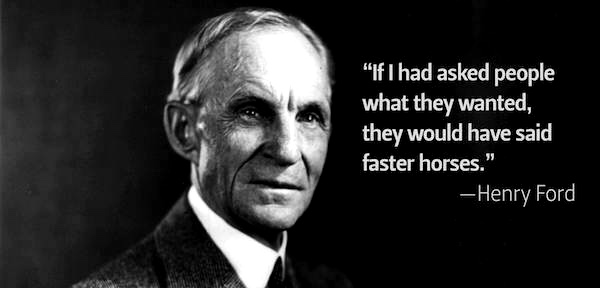
Welcome to day 2 of the 30 Day Business! I hope you’re excited about what’s ahead today, I know I am!
Today we are going to dive into the value chain and business structure of each of the five ideas that we ended with yesterday.
By the end of today you should know the key partners, activities, resources, and cost structures related to each of your 5 ideas. You will also work on defining and refining your value proposition and uncovering what relationships you need to have with each of your customer segments and the channels you will service them through. Finally we’ll dig a little deeper into the various revenue streams that you can reasonably expect from the value chain and business structure that you’ve mapped out.
There is a lot to unpack so let’s jump right in!
We’ll move through the topics in the following order:
- Customer Segmentation & Value Proposition
- Customer Relationships & Sales Channels
- Revenue Streams
- Cost Structure & Key Resources (tomorrow)
- Key Partnerships & Key Activities (tomorrow)
Now that we have a good outline of what to expect today, let’s get started with the most important part of any value chain – and not ironically it’s at the very end of the chain – the customer!
Download the attached file to fill it out as you follow along!
Customer Segmentation & Value Proposition
Before you can segment your customers in to different groups, you first need to answer the question of who your customer is! The answer to this question is so important that there are hundreds of marketing books, thousands of blog posts, countless conversations, and just as many sleepless nights dedicated to answering it!
Knowing who your customer is so important because it’s the customer that ultimately decides whether or not to give you money for your products or services. It’s the customer that decides if they want to engage in a long-term relationship with your subscription service. It’s the customer that leaves positive or negative reviews. It’s the customer that shares your product with their family and friends, or discards it in the nearest trash can. Learning as much as you possibly can about your customer is the single most important thing you can do when deciding what product or service your business should focus it’s energies on!
Now, getting into the minds of your customers isn’t necessarily easy. Many ways have been devised to extract what customers actually want. And just as often as a customer tells you what they want, you’ll realize that they have no idea what they actually want. This often ends with you standing face to face with your customer, silently staring at each other with blank looks on your faces.
On the other end of the spectrum of knowing what your customer wants are those brilliant innovators that push forward with seemingly reckless-abandon to create something they have convinced themselves that customers will want – developing in isolation without any sense of what the the customer is saying they want.
I don’t mean to imply that every product decisions needs to be made based on existing market data. I also don’t think that market data is always helpful if you don’t know how to analyze it properly. But this still leaves us standing here with the same question; what do our customers want?!
Lets try to answer that question indirectly, using a famous quote from Henry Ford:
“If I had asked people what they wanted, they would have said faster horses”
Henry Ford (probably)

And so the story goes, Henry Ford set about to build a faster horse…🙄
Actually, Henry Ford is known for something else… I’ll have to google it, cause I think he’s only know for that quote… kidding….😅
Anyway, that quote has all the magic we need! Hidden in that quote is the answer to the question we are asking about our customers. But, his statement answers a slightly different question. Henry Ford isn’t answering the question, “what do people want?”. Instead, he is answering the question, “What problem are people trying to solve? How are they solving it today? Is there a solution that I can provide that helps them solve their problem better, faster, in more style, with more friends, with a better reputation, etc…?”
Steve Jobs was also famously quoted as saying:
“A lot of times, people don’t know what they want until you show it to them.”
Steve Jobs, BusinessWeek, May 25, 1998
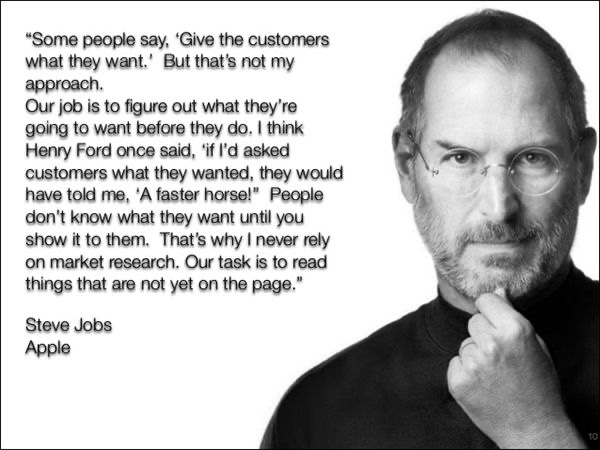
I’ll add that people are much better at discerning their pain and problems than the solutions that will make their lives better. As humans we seem to hold on to our suffering as if it’s a badge of honor or a name tag that other can identify us by. But that’s the secret of good market research. Find the problems, not the solutions. Endless supply, don’t say I didn’t warn you!
Henry Ford and Steve Jobs weren’t ignoring the market or the needs of their customers in their statements. They were demonstrating what every great marketer should do when trying to reach a customer: Understand the underlying struggle, challenge, problem, jobs-to-be-done for their customer, and only then can they offer something perfectly tailored to do meet customer needs.
In the book “Competing Against Luck” by Clayton Christensen, we learn about the Jobs Theory. No, this isn’t about Steve Jobs the Founder of Apple. Although, Steve Jobs is wrongfully attribute with having blinders on to what customers want, similar to Henry Ford. But a closer look reveals that that Steve and Henry got to have their cake and eat it too. They didn’t rely on customer surveys to make product decisions, but they both are celebrated for know exactly what the public will buy when the product they offered had no historical precedent!
How did they do that?
Apparently, it’s easy. Simple, even. And Clayton Christensen seemed to have cracked the code in his book Competing Against Luck!
“[T]he Theory of Jobs to Be Done … focuses on deeply understanding your customers’ struggle for progress and then creating the right solution and attendant set of experiences to ensure you solve your customers’ jobs well, every time. ”
Clayton M. Christensen. “Competing Against Luck.”
So, now we have a good question – even though we actually set out looking for answers, but we’ll take it!
What are the Jobs to Be Done for your customers? The products that you create are being hired to do certain jobs for your customer. And that is your value proposition! Easy, right?
The best part is, when your products and services do their jobs well for the customer, it creates an almost impossible barrier for your competition trying to impacting your business and take away your customers. When you focus on jobs-to-be-done you are creating more than just an item for sale, you are meeting the customer’s needs with the product, the sales process, the service environment, and the entire experience. And because you know what job your product has been ‘hired’ to solve, you can create additional products that complement the first without fear of the market rejecting it. Making innovation less of a risk.
And that’s the secret behind Henry Ford and Steve Jobs knowing what to build for the people, without relying on market data to spell it out for them.
Action Item: What Job(s) are your customers hiring products to do for them? What currently performs these jobs for your customers? What Job can your product perform for them? Can your product be hired for a job that seems to be unrelated to its designed purpose?
Sales Channels & Customer Relationships
How do you reach your customers? How do they expect to be reached? Where do your customers currently buy products that are similar to yours? The answers to these questions will give us a good idea of what sales channels we should be targeting as part of our distribution strategy!
There are five phases to a sales channel: awareness, evaluation, purchase, delivery, and support. Let’s walk through each phase and see how we can connect the dots for our business ideas.
Awareness
It might sound obvious, but there needs to be a way for people to become aware of your products. Life isn’t like The Field of Dreams that is famously quoted saying “if you build it they will come.” If you only build it, there is no guarantee that anyone will come. That only happens in the movies, guys… and movies aren’t real. Well they are real cause they exist, but that doesn’t mean they are the source of marketing truth.
There needs to be some serious thought around how to get the attention of your potential customer. Having the perfect value-proposition and aligning your products with the jobs your customers need to get done. That’s only half the story. You need to have the best funnel along with the best solution for your customers.
To be clear, the best funnel is necessarily the one that has the highest volume of people running through it. The best funnel is the one that bring the right people through it. The people your product will really help. Your awareness campaign that will bring in your best customers is often their first exposure to your brand and your offering!
If you are targeting people who shop in a cold detached manner, that are only looking for the lowest prices you’ll actually do much better if your funnel is cold and detached as well. However, if you are creating product and solutions for warm-blooded people, then your funnels need to make then feel at home, at ease, and willing to listen. They need to feel – as well as see – that your product is the one they want to hire to perform a specific job.
The point is, you need to make your customers ‘feel the love’ from the moment they are exposed to your brand. And that attention and care needs to continue as long as they are a consumer/user of your product – even if they haven’t made a purchase in a while.
Action Item: Brands do you feel a connection with? Did you feel that connection the first time you were exposed to the brand? Brainstorm how your brand can create an experience that is meaningful and long lasting.
Evaluation
Once you have a customer engaged with the messaging around your product, your ability to help them evaluate your Value Proposition is key!
If you’ve done your homework and created a product that is perfect for doing the jobs your customer needs doing, it’s going to be a no-brainer for them to pull the trigger and make a purchase! Not once, but repeatedly. Which is the ultimate objective, repeat customers who feel no need to look anywhere else for solutions.
Purchase
The purchase process requires a mix of speed, efficiency, accuracy, and an appropriate mix of technology. Historically, the payment method that you chose to accept from your customers could result in lost customers who couldn’t pay. If you have products online, you can offer any payment method under the sun to your customers and it all costs about the same to you. When we get to the implementation phase of our 30 days, we’ll explore ways to get setup with everything you need to accept credit cards, digital wallets, etc.
Delivery
Delivery can be broken down to 2 different considerations. 1. How do you get your product into the hands of your customer, and 2. At what frequency are you delivering your solution to your customer?
If you are offering a digital product, there are countless places where you can host and delivery products. You can leverage an existing 3rd Party platform. Host the products on your own website, or you can send the products to your customers.
When you leverage a 3rd party delivery platform, you lose a lot of control over the user experience. However, 3rd Party platforms bring with them the benefit of much higher traffic – typically free to you! So, the tradeoff with leveraging 3rd party Platforms for digital content delivery is that you lose a degree of control over the user experience in exchange for higher traffic. Depending on your objectives, you could reasonably pick either solution!
Self-hosting a website and content delivery platform gives the highest degree of control over the user experience. The trade-off when you control the entire user experience is that you also need to maintain and enhance the platform as technology becomes obsolete or when a portion of your platform crashes from a security breach.
Fortunately, there are solutions that are a good combination of 3rd party technologies that give you near-complete control over the user experience. There’s also solutions that will handle all the technical issues that might arise so you can focus on your customers and improving their experience with you. This comes with a price tag, but these types of services are so cheap that it’s not even worth discussing further.
After Sales
This part of the channel could just as easily be called pre-sales. Your job is never done. As long as your product is doing a job for your customer, that are your past, present and future customer. So, taking care of them with customer support, replacement parts, refunds, technical solutions and anything else that might be required is just as much an after sales activity as it is a pre sales activity.
If you are selling content or training material, this represents more than just servicing the delivery and sale of your product. It also represents answering questions that come from the content you have created. Be prepared to teach and teach again until you’ve explained your expertise in every way and from every angle imaginable!
Action Item: Write down what your sales channel could look like. Compare your assumptions against existing sales channels for similar products you can find online.
Customer Relations
The topic of customer relations is broad, and is very much connected with the channels that you chose to work through as you interact with your customers.
Your customer relations strategy might be centered around self-help FAQ on your website, or community driven Q&A forums. However you plan to manage the relationships you have with your customer base, make sure you execute on it intentionally.
If there is something that will get you bad reviews fast than anything else online is a lack of responsiveness.
If you say you’re available via phone, have a phone number on your website and answer it. If you say you’re available via twitter, Facebook, instagram, etc. Then be available there and respond to your customers with a tone and care that you’ve put into the product and experience that you’ve crafted for them.
Getting your customer relations right is what can move your customers from a transactional buyer to an advocate that will preach your greatness from the rooftops! Take care of your people!
Action Item: what type of customer relations strategy works best for your business? How can you set this part of the business up to complement and enhance your efforts to provide a high quality experience around your core products?
Revenue Streams
Have you thought about how you are going to make money with your business? I know you’ve thought a lot about building something that you think is great… But, how can you exchange your hard work for money? Have you considered your options get paid in multiple ways from different market segments for the same work?
Revenue stream can be thought of in 2 different ways. the first way is from a on-time transaction with a customer that pays you money in exchange for permanent and irrevocable possession of your product. the second way is a model that enables recurring revenue from ongoing payments from customers. These repeat payments could be for support on the goods they purchased or it could be payments for continued access to a library of content that is added to over time – like Netflix movie subscriptions or Amazon’s Unlimited book subscription.
So, how are you going to price you products? What type of revenue stream make the most sense for the type of product you are selling?
Lets answer that question and be done for day 2!
Congratulations on making it to the end of Day 2!
We filled out Half of the Business Model canvas and answer some crucial questions about each of the 5 ideas we got from our work yesterday. After tomorrow, you should have a really good idea of which ideas you’ll want to move forward with for the rest of our 30 Days! But, we’ll have to wait until tomorrow to get that answer!
Until then!
Day 1: Narrow Ideas to 5

It might seem like a silly thing to think that you can create a business that generates money that you can eventually live off of. And it might also seem silly to think that ideas that have been floating around in your head for years are going to be the catalyst to that money generating business. But it’s not so silly when we can point to data that clearly outlines the repeatable steps that are necessary to succeed.
By the end of the day you will have learned and accomplished 2 very crucial concepts and activities:
1. You will have a clear understanding of what makes a good business/product idea, and
2. You will have done objective data-driven analysis on ideas that were formally validated only by your subjective emotions.
Outline for Day 1:
- Write down your Business/Product ideas
- Use This Criteria to find ideas that deserve your time and energy
- Categorize ideas by Business Objective
- Ranking Ideas
- D.E.F.T Framework (Document, Evaluate, Focus, Test)
- 27 Honest Questions
- Back-of-napkin Financial projections
- First Mile Certainty Analysis
Write Down Your Business/Product Ideas
The very first thing we are going to do is write down our ideas. To be thorough, we are going to start with a broad net. We want to capture everything, including the stuff that we will ultimately dismiss.
Before you start capturing Everything that pops into your head, keep in mind that there are a few criteria that I’ll be using to determine if the idea that I’m exploring is good enough to be explored.
The criteria that I will be using to measure the success of the next 30 days is:
- Profitable
- Sustainable
- Repeatable, and
- Legal
You can see the expanded version of this list in a previous post where I describe and provide an outline to the 30 Day Business process.
So, that excludes certain ideas from the list right away. Including those easy-out solutions like asking family for money selling your possessions to cover your costs. We’re making real businesses that make real money. They will be small at first, but they will be designed to grow.
Action Item: Write down all the business ideas that meet your basic criteria for success.
Criteria for Ideas that deserve your time and energy
I spent some time in a two-part piece talking about Ideas and which ones are worth pursuing. Part 1 talks about how you can know if something is a good idea instead of just an idea that you like. Part 2 talks about what you can do to wrap your arms around ideas that are good and worth pouring your energy into.
I spent some time this morning re-reading from a book called Big Magic by Elizabeth Gilbert (author of Eat Pray Love). The book is less practical than what I typically read, but there was something that stuck with me the first time I read it, and I still think about it often. The core message of the book with the following excerpt.
“I believe that our planet is inhabited not only by animals and plants and bacteria and viruses, but also by ideas. Ideas are a disembodied, energetic life-form. They are completely separate from us, but capable of interacting with us—albeit strangely. Ideas have no material body, but they do have consciousness, and they most certainly have will. Ideas are driven by a single impulse: to be made manifest. And the only way an idea can be made manifest in our world is through collaboration with a human partner. It is only through a human’s efforts that an idea can be escorted out of the ether and into the realm of the actual.
Excerpt From: Gilbert, Elizabeth. “Big Magic.” Penguin Publishing Group, 2015-09-22.
Therefore, ideas spend eternity swirling around us, searching for available and willing human partners. (I’m talking about all ideas here—artistic, scientific, industrial, commercial, ethical, religious, political.) When an idea thinks it has found somebody—say, you—who might be able to bring it into the world, the idea will pay you a visit. It will try to get your attention. Mostly, you will not notice. This is likely because you’re so consumed by your own dramas, anxieties, distractions, insecurities, and duties that you aren’t receptive to inspiration. You might miss the signal because you’re watching TV, or shopping, or brooding over how angry you are at somebody, or pondering your failures and mistakes, or just generally really busy. The idea will try to wave you down (perhaps for a few moments; perhaps for a few months; perhaps even for a few years), but when it finally realizes that you’re oblivious to its message, it will move on to someone else. But sometimes—rarely, but magnificently—there comes a day when you’re open and relaxed enough to actually receive something. Your defenses might slacken and your anxieties might ease, and then magic can slip through. The idea, sensing your openness, will start to do its work on you. It will send the universal physical and emotional signals of inspiration (the chills up the arms, the hair standing up on the back of the neck, the nervous stomach, the buzzy thoughts, that feeling of falling into love or obsession). The idea will organize coincidences and portents to tumble across your path, to keep your interest keen. You will start to notice all sorts of signs pointing you toward the idea. Everything you see and touch and do will remind you of the idea. The idea will wake you up in the middle of the night and distract you from your everyday routine. The idea will not leave you alone until it has your fullest attention. And then, in a quiet moment, it will ask, “Do you want to work with me?”
I love this quote. I love this idea. I don’t know if ideas are independent entities that are searching for a host to bring it to the world, but I absolutely agree that an idea unheeded will eventually leave you and become somebody else’s.
Ideas are powerful. The right idea in the right hands can change the world! The right idea in the wrong hands can destroy a life.
It’s very important to align your competencies with your passions and much as possible when selecting a business/product idea. Something we’ll talk more about when we do the First Mile Certainty exercise later.
Categorize ideas by Objective
Ok, you should have a list of ideas that you’ve created. Your free-form brainstorm had very few constraints – only that they needs to generate some amount of money.
Now we are going to categorize the ideas in to different segments by their objective. This exercise will help you get a better idea of the motivation behind the idea, and what successful deployment looks like.
Answer the following questions about each one of your business/product ideas and place them into one of Business Objective Categories listed below:
- Generate high-volume sales
- Generate high-profit margins
- Create a work environment that is enjoyable
- Take a piece of an existing market
- Enhance your personal brand
- Improve the performance of an existing process
- Solve a specific problem
- Positively impact the world
Your idea might fall into more than one of the categories above. Which perfectly ok, most of the ideas I have fall into more than one category. If your idea doesn’t fall into any of the categories above, create a new category and describe what the objective of the Business/Product is.
Keep in mind, this exercise isn’t asking what you want to do with the money you make from your business/product. having money to spend is definitely a motivation for working hard at your business, but that shouldn’t be confused with the Business Objective of the actives your Business/product will engage in. or what your Business/Product will be used for by your customers.
Action Item: Categorize your business/product idea into the Business Objective categories above.
Ranking your ideas
There are several different ways to rank your ideas – how fun they will be, how cool you will look doing it, how much time investment it will require, how broke you will be if you fail.
Before we get into more rigorous analysis, you need to rank your ideas from best to worst. Use a general measuring method here based on your gut instinct.
Let your best ideas float to the top and the ones that seem silly or impossible should sink to the bottom of your list.
Later we’re going to rank each of your ideas by how much money you can expect to make if each one was reasonably successful over a 12 month period.
But for now, just rank them with the simple metrics of good, better, best. (hopefully you didn’t bring any of your bad ideas with you today…)
Action Item: Rank your ideas from best to worst using Good, Better, Best metrics
D.E.F.T Exercise (Document, Evaluate, Focus, Test)
The DEFT framework is where the real analysis begins. Up to this point, you should have your ideas written down, along with the Business Objective category that each one falls into. You then ranked them based on your gut instinct into good, better, best categories.
The DEFT framework is inspired by “The First Mile: A Launch Manual for Getting Great Ideas into the Market”, Harvard Business Review Press, Scott D. Anthony. Others have articulated the same basic concepts when testing your business hypothesis, but I like what comes next – the 27 Honest Questions that will really put your ideas to the test.
Action Item: Answer the 27 Honest Questions about each one of your business/product ideas.
27 Honest Questions
You can download the attached file that has all 27 questions for you to answer. Feel free to print it out, or answer by writing on the PDF on your computer.
As you answer these questions, you are giving an answer to the best of your knowledge today. Over the course of the 30 days, we are going to learn how to do the market analysis that will yield objective answers to these questions. But first, we are going to familiarize ourselves with these concepts and get our minds thinking about the issues that actually matter when starting a business. Once we’re primed, we will be much more receptive to data and answers that might be different from the ones we came up with on our own.
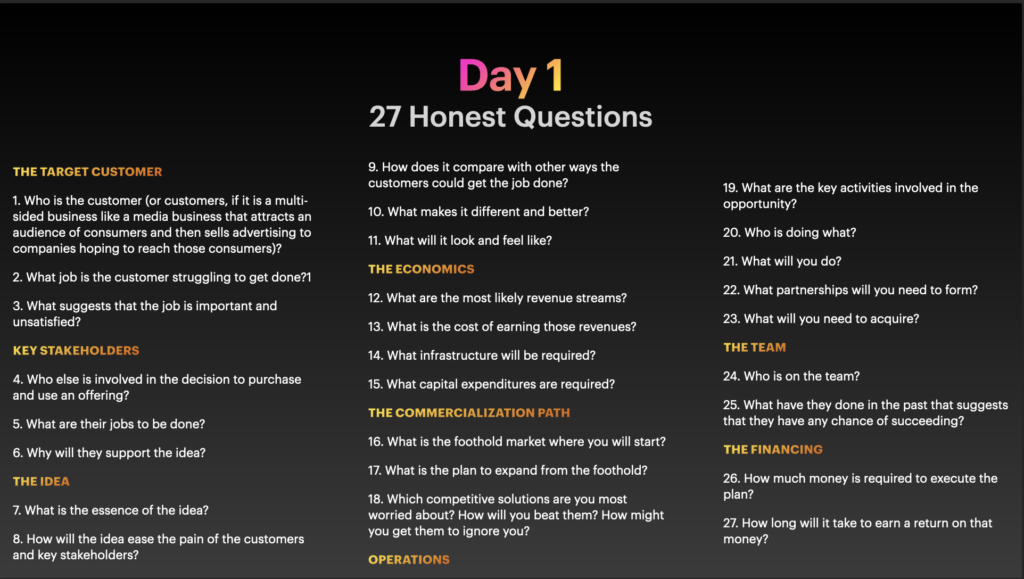
Back-of-Napkin Financial Projections
As we continue to ease into more rigorous analysis of our business ideas and eventually our final business selection, we will do more math. Nothing too sophisticated, mostly simple math like addition subtraction, multiplication, and division. We want to get a general idea of the amount of money we can expect to make if we create the business/product we’re hoping to build.
The backward way of looking at potential income from a business is to set a revenue target and then make up all the numbers that will result in that revenue number. While that would be fun, we wont to do that because it is a little too speculative. What we are going to do is create something called a reverse income statement.
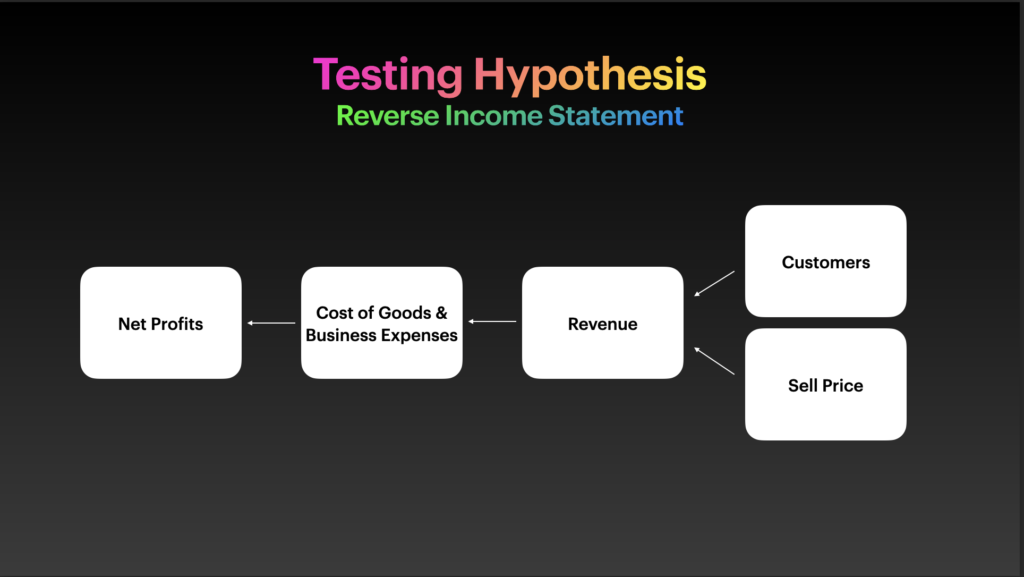
To run your idea through this reverse income statement you start from the right side and move to the left. For the customers box, you will write down the number of people you think will become your customers and pay your money – over a one month period. The sell price is the price per item. These two numbers will give you the Revenue number. After revenue, you will subtract the costs per unit multiplied by the number of units you sold and then subtract the cost of doing business each month. After you’ve subtracted all the expenses, you’re left with Net Profits. This awesome number represents what you get to take home!
But, before you get too excited, lets walk through 2 semi-real scenarios. One scenario with a physical product – like a board game or fidget spinner – and one scenario with a digital product, like a song or piece of software.
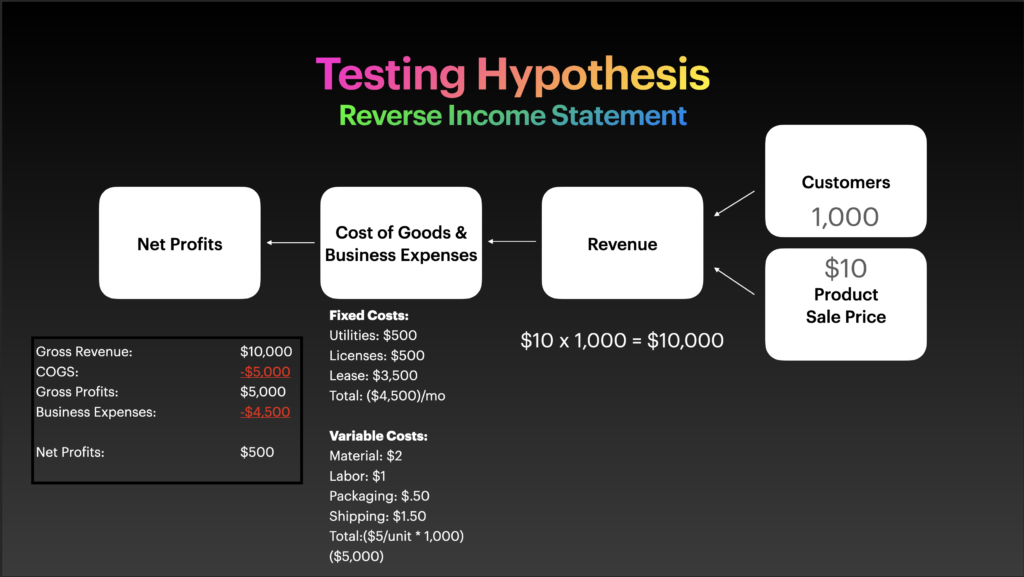
We are selling the physical product for $10 here, and we make the assumption that we can sell about 1,000 items per month. As a result, we bring in $10,000 in gross revenue. Awesome! But, then we need to cover the costs of making those products. Our cost of goods, the cost per unit x total units is $5/unit or $5,000. Right away, our revenue is cut from $10,000 down to $5,000 to cover the costs of making our product. Then we subtract ongoing business expenses, like Utilities, Software licenses, and a building lease. Those expenses total to $4,500/mo. We then subtract those expenses from the money left after covering the cost of making our physical product. $5,000 – $4,500. Uh oh! Now, this is not looking so rosy anymore. From a super exciting $10,000/mo revenue, we are only able to take home $500! Yikes!
You might be wondering how anyone makes any money selling physical products. Well, the business that makes the most money are the ones that have their costs under control – both the cost to build a product and the costs to keep the business running. They also work very hard to have super high sales volumes. With the right mixture of high volume sales and lower costs, you can start to see money coming your way!
So, if you have to pick only one area to focus on, which should it be? Should you focus on increasing sales or reducing costs?
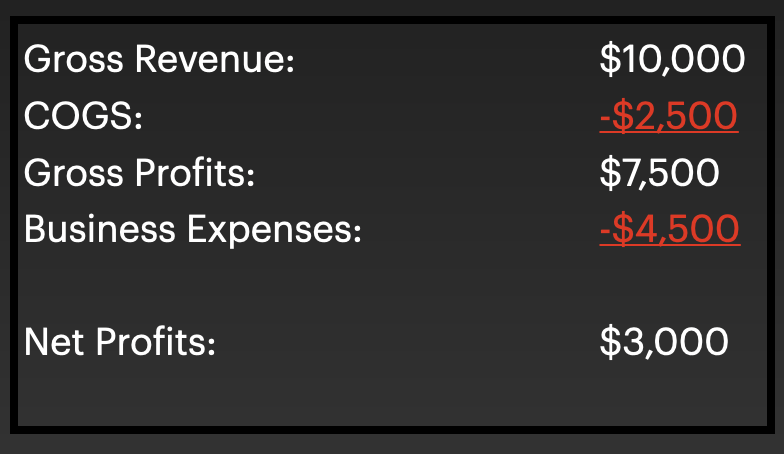
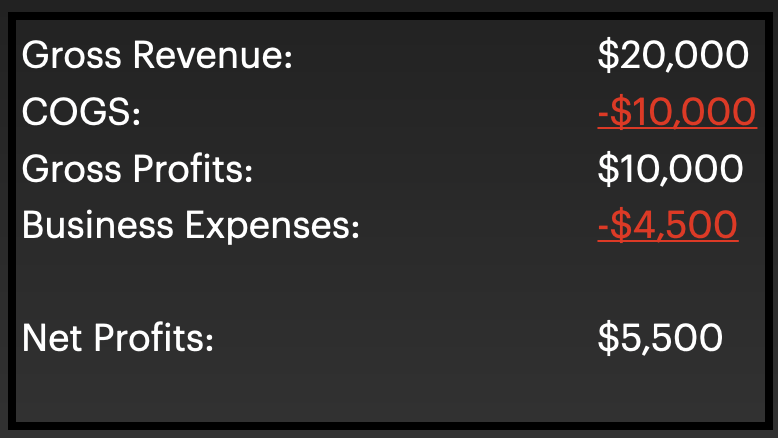
In the first adjustment, we reduced the cost of the product by 50% to $2.50/unit. That resulted in better Net Profits to $3000/mo! In the second adjustment, we kept the costs the same but doubled our sales in the month. That gave us even more profits at the end of the month.
I know I’m over-simplifying things by a huge margin. But the final scenario would be to assume we aren’t able to sell more units and we can’t change the cost structure. What’s the next thing we could do to increase our profits?
You might have guessed it; raise the price. Let’s see what happens when we increase the price by 50% to $15/unit.
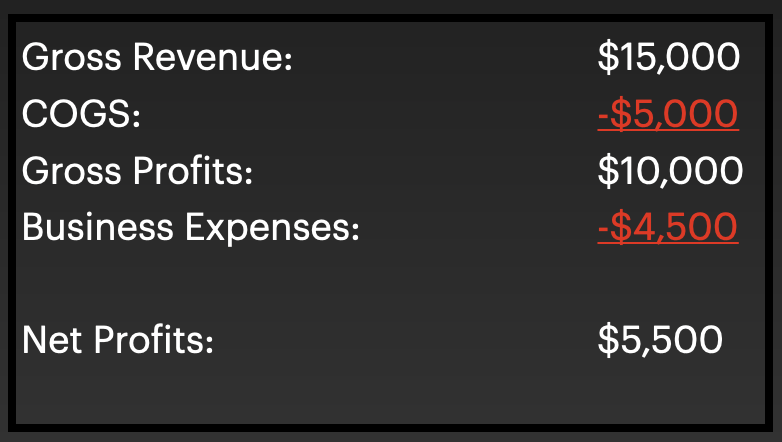
Ok, what?! We just achieved the same profits by increasing the price as we did when we doubled our unit sales. That’s crazy and awesome!
Of course raising the price can negatively impact your total sales, but hopefully you see how important powerful pricing can be when you’re in a situation where your business profits are suffering!
I don’t want to spend too much time showing you how much more money you can make selling non-physical goods. But here is the same chart swapping out the physical good for a digital one that doesn’t have any costs associated with making 1 more unit to sell.
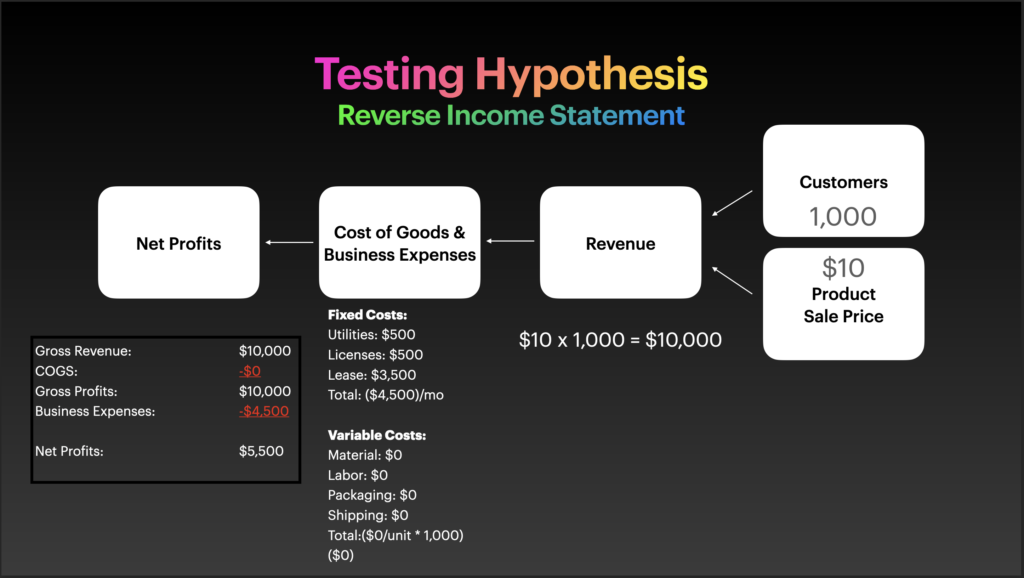
You probably noticed right away a few eye-opening things here. First, the sale price is back to the original $10/unit. Second, the cost of goods is now $0/unit. Finally, the net profits from this situation are the same as our physical goods in the extreme cases outlined. Doubling sales, or increasing price by 50%! But we didn’t double sales, and we didn’t increase the price either. But the profits are the same! Pretty cool, right?!
In a real scenario of selling non-physical goods, you’re product costs actually shift from being unit-costs to additional business expenses. There are also some accounting rules that require you to amortize the cost of developing a non-physical good over a period of time, typically the amount of time equal to the useful life of the digital good. So, you end up with something similar to cost per unit. But you’ll quickly realize that non-physical goods can scale so fast and reach so many people that even measuring costs/unit doesn’t impact the profitability of your business at all. It’s not uncommon for businesses selling digital products to have profit margins that are 80% of their revenue. Imagine taking home $16,000 for every $20,000, instead of the $5,500 profits for physical goods. I’m not biased, digital goods are difficult to make and easy to copy. Physical goods are difficult to make and difficult to copy – because the product is the entire manufacturing process, not just the output. There’s an opportunity in each segment of the market. Knowing how the money flows is helpful in making your decision on what type of business/product will work best for your
Action Item: Do a rough reverse income statement for each of your top business categories. If you need to look online to see what similar items are selling for, go grab that data. For the cost of good and business expenses, put in best-effort analysis to get rough numbers. The goal is to see where the best opportunity lies. One strategy to help you get more reliable data is to keep your business expenses the same for each of the different ideas. In the scientific community, this is called a control. Have your business expenses by the control and the product cost be the variable you are testing.
First Mile Certainty Table
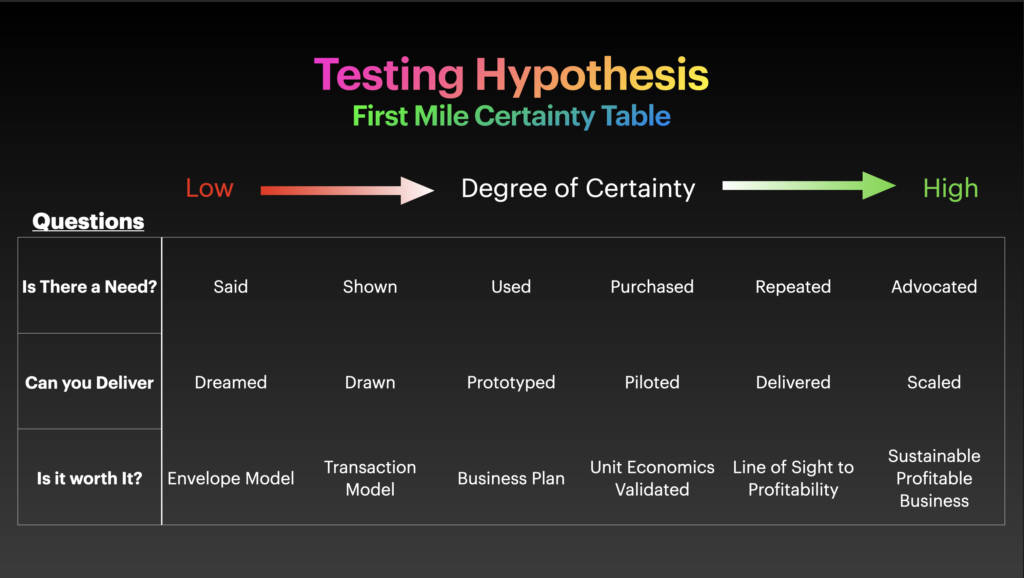
The First Mile Certainty Table can be a gut-check for most, and validating for some. Whichever camp you’re in, the outcome that you have after running your idea through each concept is extremely valuable.
How does the First Mile Certainty table work?
On the left side of the table you have 3 questions stacked vertically. 1. Is there a need? 2. Can you deliver?, and 3. Is it worth it?
Hypothetical answers to these questions are listed left to right with sample responses representing an increase in certainty as you move closer to the right side of the table. Certainty in what? Well, certainty in your business achieving success!
As a result, the business ideas that score the highest are those that you are able to provide answers closer to the right side of the chart.
Let’s walk through an example of how to use the chart for a hypothetical business selling hotdogs out of a food truck – something I have no experience with (but my brother actually did this profitably years ago)
Question 1: Is there a need for a HotDog Selling Food Truck? How intense is that need?
Answer 1: Based on the information (that is very old now) given to me by the owner of a hotdog selling food truck, yes there is a need for this business. There were predictable sales when the truck was at events, but non-recurring events like the country fair made it difficult to have predictable income. The degree of certainty for a hotdog selling food truck is moderate because the customer need falls under “Purchased” on the chart, just shy of “Repeated” since the truck was rarely in the same place at the same time
Question 2: Can you deliver a hotdog selling food truck?
Answer 2: I can imagine what it would take to build a business around a hotdog-selling food truck, but I’ve never actually sat down to write up plans. And I definitely never prototyped a food truck business model of any kind. The degree of certainty on the Can you Deliver equation is very low because I’ve only “Dreamed” or merely thought about it without every writing up plans or creating a prototype.
Question 3: Is it worth it? Does the financial model generate the money you’re expecting?
Answer 3: Conversations I’ve had regarding the economics of the hotdog-selling food truck that my brother operated gave me confidence in the business as far as the “Unit Economics being Validated”. Because there was a clear path to sell the product at a price high enough to cover costs and provide a healthy margin. But true profitability was not something that looked promising enough for me to pursue. The variables that could negatively impact the likelihood of success are very much outside of the control of the business owner. Weather and public event schedules alone quickly present themselves and massive obstacles to predictable and recurring income. Is it worth it? I’m Moderately certain it would be worth it.
Action Item: Ok, now it’s your turn to run your ideas through the First Mile Certain table see how they do! Write down your thoughts and make sure you document why your are scoring the ideas the way that you are. Take into account the answers you gave for the 27 honest questions from earlier. Your answers to that exercise should help you think more clearly about your answers to the questions in the First Mile Certainty table
Your top 5 Ideas
Let’s give your idea list a haircut and trim off the bottom!
Based on your responses in the previous section, remove all ideas from your list except for the 5 ideas that scored the highest on the first-mile certainty test.
If you are even remotely certain you can achieve one of the business ideas you have, then it should be removed from your list.
So, go ahead, pull out the scissors give your list a close trim!
Conclusion
Now that you have your top 5 ideas – and these are actually some pretty good ideas that seem to have some real potential – you’re ready for the next step in the process of narrowing down your list to the one idea that you will move forward with.
Tomorrow we are going to break down how each of your top 5 ideas could make money. This involves knowing more about your customer, more about your offering, more about your operational requirements, and more about your cost structure!
After tomorrow, you’ll have a good idea what different elements will be required to create a business that can repeatedly and reliably service a customer base that not only purchases from you, but advocates for you and your products!
Tomorrow is going to be Amazing! I can’t wait!